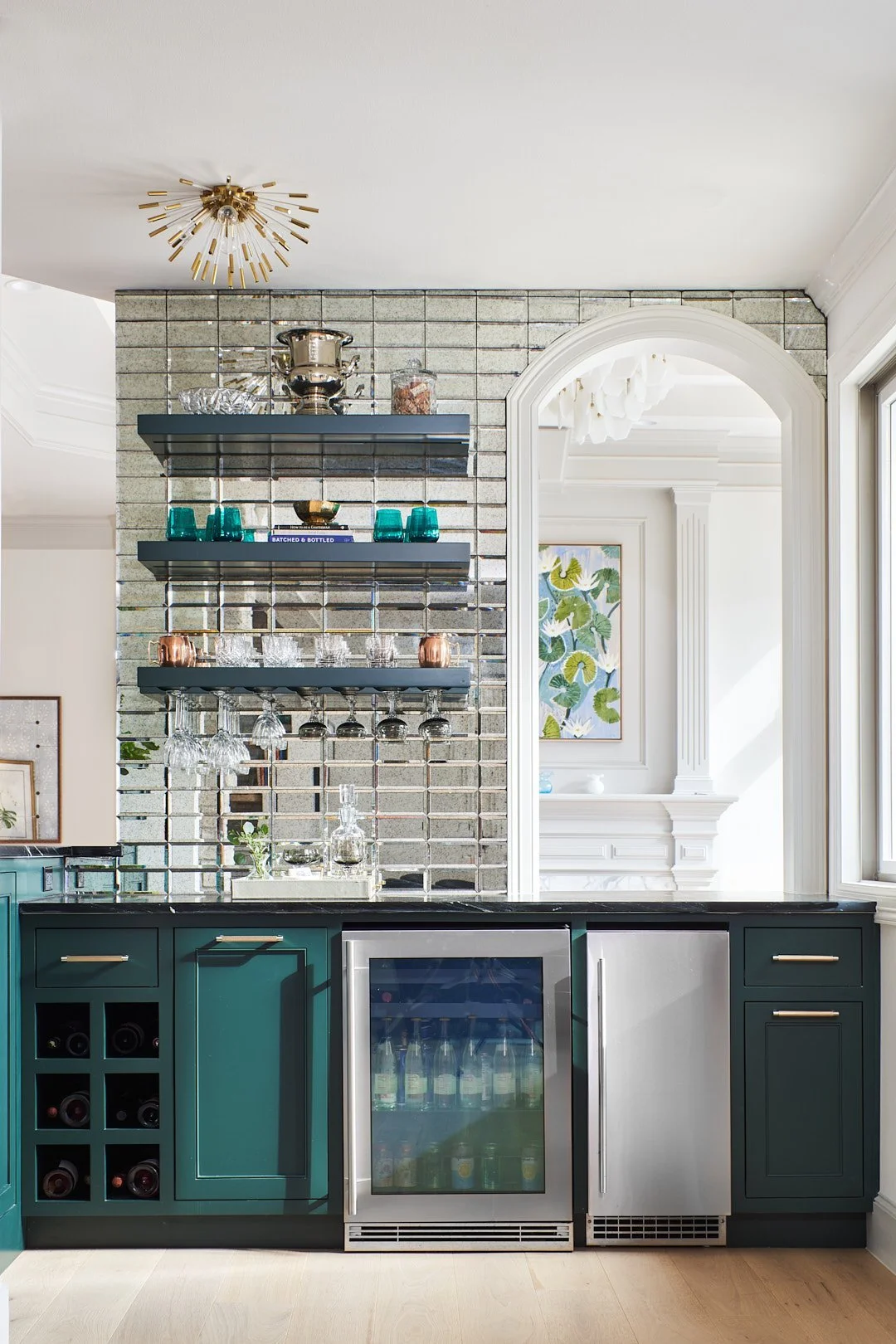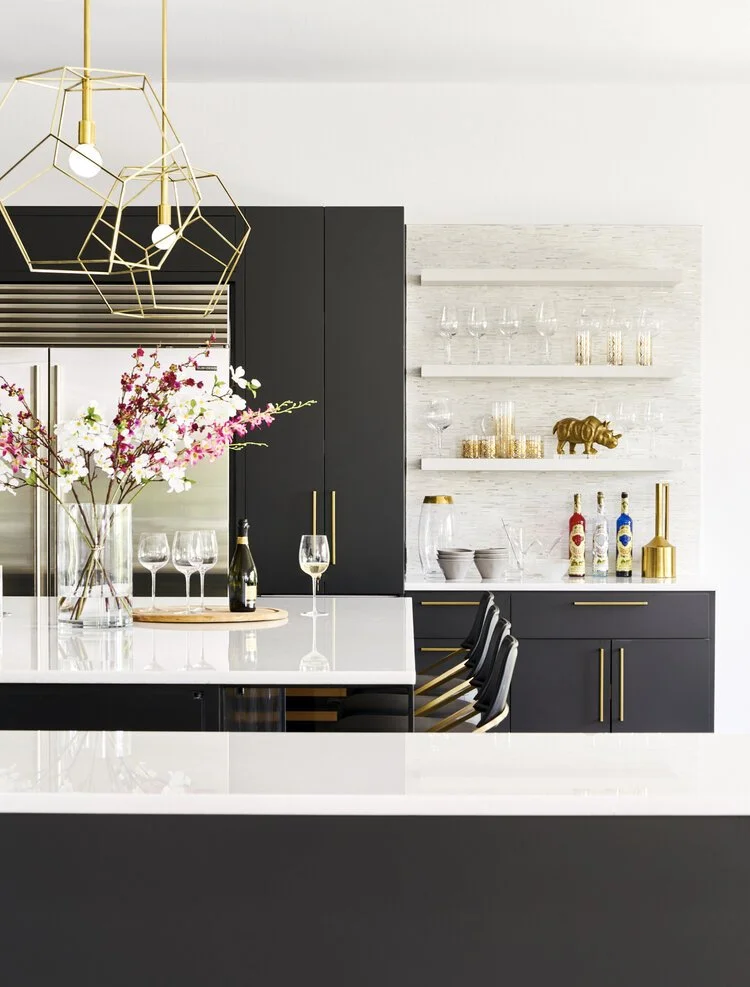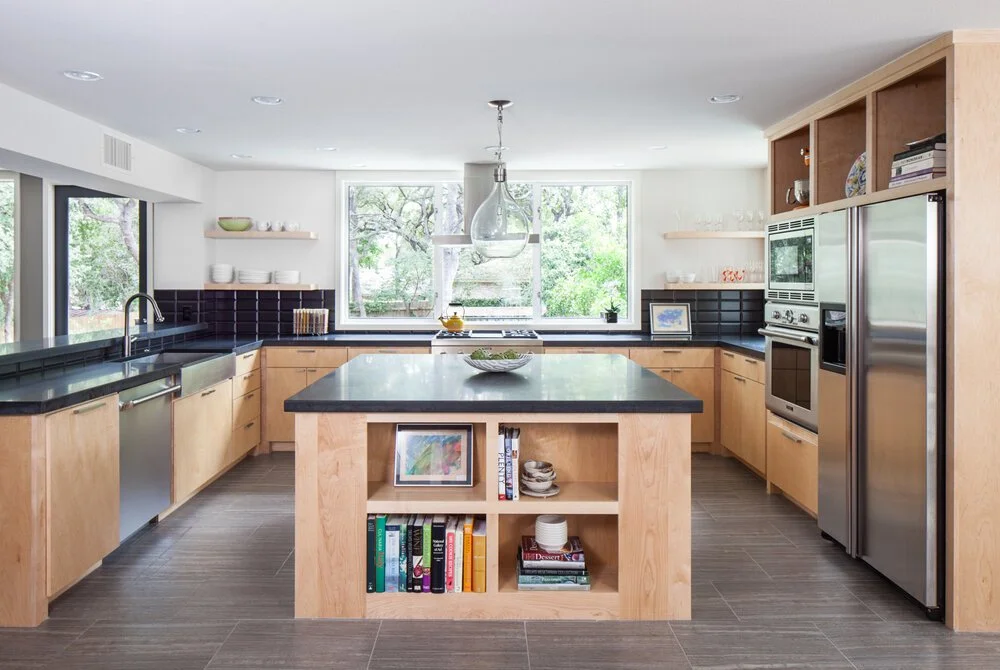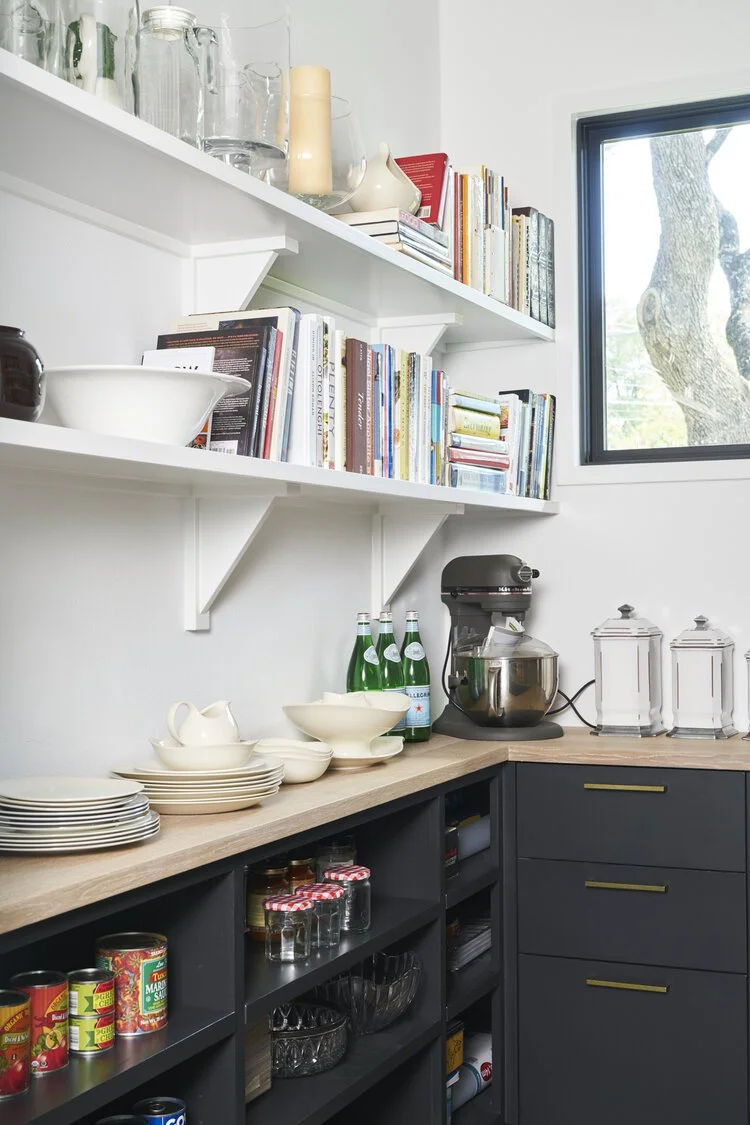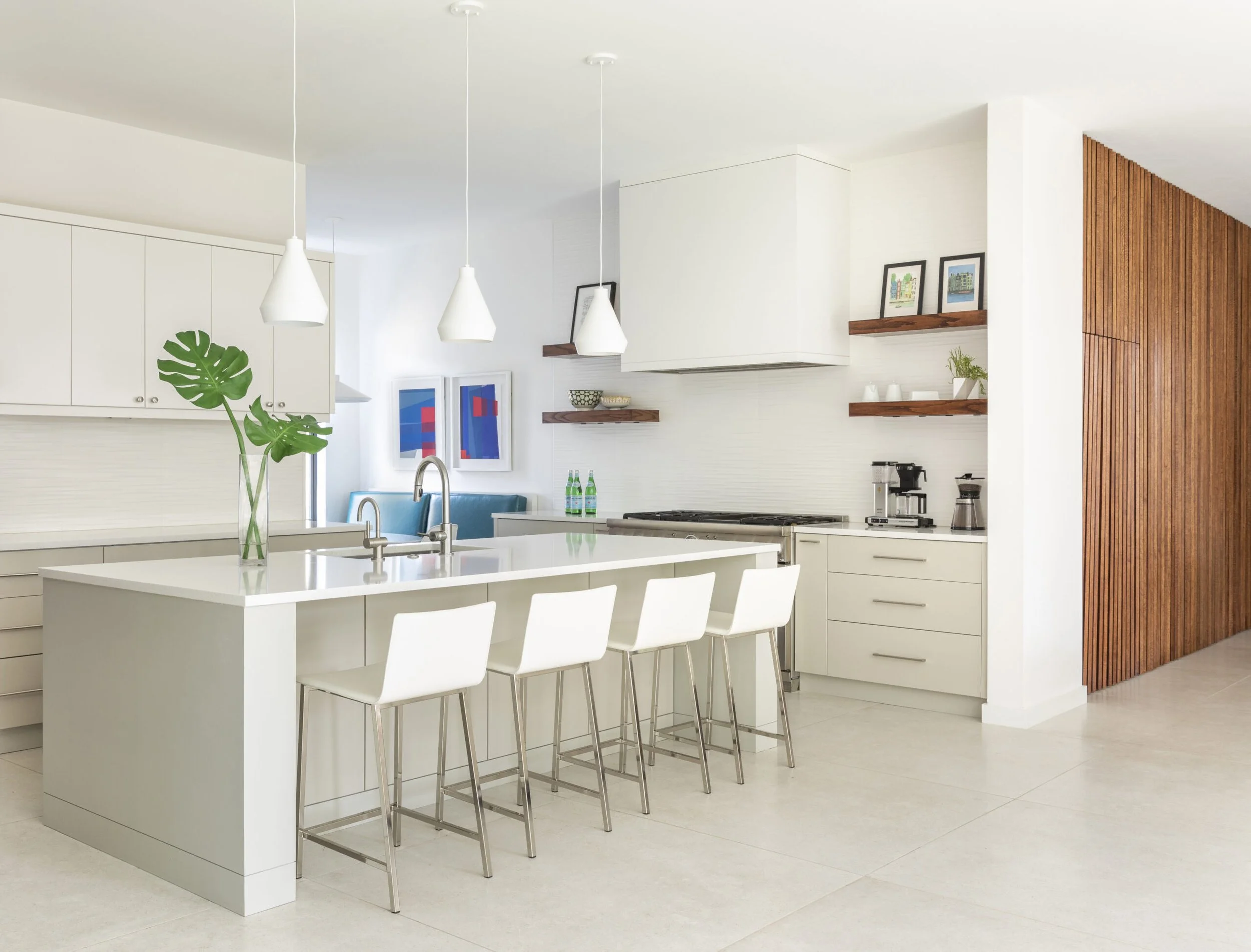Open Shelving Guide: Pros & Cons, Design Ideas, Specs, and More
Our Austin Architects Share Everything You Need to Know About Open Shelving
Are you considering open shelving for your kitchen design? Open shelving can be a beautiful way to showcase your collection of coffee mugs and a functional solution for tight corners. However, a misguided application could leave you with a cluttered storage space or a sagging shelf. You don’t want either! Our Austin architects have incorporated open shelving into many of our kitchen designs — from traditional to contemporary. We’re sharing everything you need to know in our Open Shelving Gude, from the pros and cons to design ideas and the necessary specs.
What is Open Shelving?
Open shelving is a simple storage solution without doors or side panels, allowing easy access or display. In the home-building process, open shelving falls into the category of millwork.
Millwork refers to any type of woodwork produced in a mill and is divided into casework and trimwork. Casework includes boxed construction items like cabinetry, while trimwork includes decorative pieces such as baseboard and crown molding.
While your cabinet maker is responsible for your kitchen cabinetry, your trim carpenter can typically handle open shelving. In many cases, open shelving is less expensive than cabinetry.
Open Shelving Pros and Cons
Is open shelving right for your kitchen and lifestyle? Consider all the open shelving pros and cons before committing.
Pro: Open Shelving is Stylish
Open shelving is the perfect place to showcase bowls, dishes, and other accessories, creating an exciting design element in your kitchen.
Pro: Open Shelving Has a Light, Airy Feel
Open shelving feels visually lighter than upper cabinets. Using them can help make a small kitchen feel larger or further enhance the spacious feel of an open-concept kitchen design.
Pro: Open Shelving Keeps Items Accessible
Open shelving can also be a very functional part of your kitchen layout, allowing for easy access to frequently used items.
Con: Open Shelving Can Look Cluttered
Open shelving puts all your items on full display. If you don’t have time to keep things organized and styled, they can quickly look cluttered and messy.
Con: Open Shelving Can Be Difficult to Clean
Open shelving might require more cleaning than traditional cabinets. While you can easily wipe down your cabinet doors, items on a shelf may collect dust or get splattered with oil if near the stove.
Con: Open Shelving Might Offer Less Storage Space
Shelf widths vary in depth and may be shallower than traditional upper cabinets, resulting in less storage space. Even shelves of the same depth offer less usable space because items need to be arranged aesthetically rather than compactly.
Is Open Shelving Right for My Kitchen?
Well, it depends! There are many elements to consider when designing a kitchen, including style, function, and space. In one kitchen, opting for open shelving could mean sacrificing the additional storage traditional upper cabinets offer. However, a kitchen with a quirky floor plan might actually be made more functional with open shelves that fit into a corner too small for a cabinet. If you have a butler’s pantry, storage may not be a concern, allowing you to focus solely on aesthetics. Assess your space and consider what’s most important to you.
Is Open Shelving Cheaper Than Cabinetry?
It also depends! However, open shelving is typically less expensive than cabinetry because it requires less construction, materials, and hardware. As mentioned earlier, you can also have your trim carpenter build open shelves, freeing up space in your cabinetry budget. However, prices can fluctuate based on the chosen woods and shelf span, as well as features such as built-in lighting or hidden outlets.
Open Shelving Design Ideas
Open shelves provide the perfect opportunity to accent your kitchen and get creative with your design plan. Here are some open shelving design ideas to consider and spark your imagination.
Open Shelving Material Options: Wood, Metal, Glass
Open shelves can be made of wood, metal, or even glass. When choosing a material, consider the style of your kitchen cabinets and what you intend to store. The selected material should complement other finishes in the kitchen and be able to accommodate your items. For example, thick wood shelves would be suitable for storing bowls and even small pots, while more delicate glass shelves would be better suited for wine glasses.
Open Shelving Upgrades: Built-in Lighting & Hidden Outlets
You can also upgrade your open shelves with built-in lighting and hidden outlets. Thanks to its sleek design, LED strip lighting is relatively easy to conceal. However, concealed outlets will require a much thicker edge banding, making for a thicker shelf.
Open Shelving Technical Specs
When it comes to open shelves, form follows function. Many open shelf guidelines must be considered during the design process. The final specs will be influenced by the span length, what the shelves need to hold, and the desired look. For example, floating shelves in the kitchen will need to be cantilevered off the wall with brackets and have a limited span. However, standard open shelving in a pantry can be designed with support stiffeners like a bookshelf for a longer span but with a less streamlined look. While a trim carpenter can design most open shelving, more complicated designs may require the expertise of a cabinet designer. Here are a few general open shelving specs to keep in mind.
The Laws of Cantilevering
Open shelves are supported by the laws of cantilevering. In other words, a shelf needs to be properly anchored and supported by the wall it's attached to. Anchors, cleats, or brackets must be used to support the shelf and ensure it can handle the storage load. This will depend on the span and intended use.
Open Shelving Depths
The required depth of your open shelf will depend on what you want to store. An 8” to 9” depth will accommodate coffee mugs and glassware, and 10” to 11” will hold most dinnerware. A 12” depth will be necessary if you want to store pots, pans, and larger items. For reference, most upper cabinets are 12” deep, but some can be as deep as 24”, depending on the kitchen.
Open Shelving Length Spans
The length of your open shelf will depend on the chosen material, its thickness, and what you intend to store. For example, the longest span for a 3/4" thick wood shelf is 36” long. The spans on a traditional bookshelf design can’t go longer than 30” without a 1.5” stiffener joint.
Open Shelving Height Clearances
When hanging one or multiple shelves, you will have to consider height clearances between the countertop and each shelf. So, what is the right height for a kitchen shelf? Typically, open shelving should start 18” to 24” above the countertop and include 12” to 15” between each shelf. However, this may change depending on what you intend to store. For example, an open shelving system for spices would require much less clearance than one for long-stemmed wine glasses.
Open Shelving Edge Bandings
Edge bandings are like trim around the open shelf. The thickness will be determined by the style and also any elements that need to be concealed in the shelf construction, such as anchors, lighting, or outlets.
Still, Considering Open Shelves for Your Kitchen?
As you can see, there are many design and technical considerations to keep in mind when designing a “simple” open shelf. It’s best to plan the design alongside your architect, who can coordinate specifications with your builder and carpenters. If you’re interested in including open shelves in your kitchen design, contact our team of Austin architects today. We’d love to help guide you through the process!
Do You Need Help Designing Your Home?

